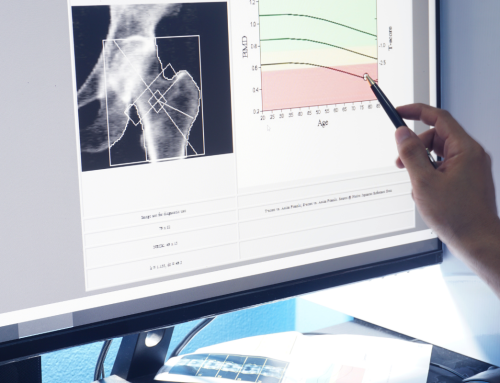
Bone health isn’t just about what’s happening today. It’s about what your bones are telling you about tomorrow. One of the most widely used tools to assess bone health is BMD—short for bone mineral density. But, while BMD provides valuable insights, it’s only part of the story. To truly understand fracture risk and long-term mobility, we need to look at BMD in the context of other key predictors.
In this article, we take a future-focused look at how BMD helps forecast fracture risk and why it’s time to look beyond the numbers alone when it comes to protecting your skeletal health.
What Is BMD (Bone Mineral Density)?
BMD measures how much mineral (mostly calcium and phosphorus) is present in a segment of bone. It’s commonly evaluated using a DEXA scan and is used to diagnose conditions like osteopenia and osteoporosis. Lower BMD values are generally linked to an increased fracture risk.
But here’s where it gets more complex: some people with lower BMD never break a bone, while others with normal BMD scores do. Let’s explore why that happens—and what else we should be paying attention to.
BMD’s Predictive Power (and Its Limits)
Bone mineral density is a powerful predictor of fracture risk, but it’s not a crystal ball. Research shows that for every 1 standard deviation drop in BMD, fracture risk roughly doubles. That’s significant—but BMD is just one puzzle piece.
Why Two People With the Same BMD Can Have Different Fracture Risks
Imagine two individuals with identical BMD scores. One is active, has strong muscles, and has good balance. The other struggles with poor coordination, takes corticosteroids, and has a history of inflammation. Their fracture risk profiles? Completely different.
That’s because BMD doesn’t measure:
✗ Bone quality—including microarchitecture and internal bone structure
✗ Fall risk—related to strength, balance, and neuromuscular control
✗ Medication use and chronic inflammation—both of which can degrade bone integrity
Beyond BMD: What Else Predicts Fracture Risk?
Clinicians increasingly use tools like FRAX (Fracture Risk Assessment Tool), which combine BMD with other factors such as:
- Age
- Fall history
- Use of corticosteroids
- Family history of fractures
- Secondary causes of bone loss, like rheumatoid arthritis
This comprehensive approach provides a 10-year fracture risk estimate and gives a more accurate picture of future bone health.
Why Bone Strength Is More Than Bone Density
Falls account for 95% of hip fractures in older adults. That makes muscle mass and balance just as important as BMD (bone mineral density) in preventing fractures. Weak muscles and poor coordination can turn a minor stumble into a serious injury.
Incorporating balance training, resistance exercises, and proprioceptive drills into your routine can dramatically reduce fall risk—even if your BMD is low.
What the Latest Research Says
Emerging science is helping redefine how we assess and manage bone health.
- Bone quality matters as much as bone density. A 2024 study found that people with subtle damage to the internal structure of their bones (like the trabecular and cortical layers) had a higher risk of fractures, even when their BMD scores weren’t severely low.
- New biomarkers are changing the game. A 2024 review in Frontiers in Endocrinology examined the use of bone turnover markers (CTX and P1NP) to predict fracture risk. These biomarkers may reveal vulnerabilities that DEXA scans alone can’t detect.
The message? It’s not just about how much bone you have—it’s about how well that bone functions.
Advanced Strategies to Reduce Fracture Risk
Instead of focusing only on increasing BMD, consider a broader, more functional approach to bone health:
1. Marodyne LiV: A Groundbreaking, Non-Invasive Option
Marodyne LiV uses Low-intensity Vibration (LiV) to activate bone cells and support both bone formation and muscle activation. Backed by decades of research and developed with input from NASA scientists, it’s a safe, scientifically validated option designed to improve bone strength, balance, and coordination—not just density.
- Stimulates bone remodeling
- Enhances neuromuscular feedback
- Supports fall prevention through stability
2. Balance and Stability Training
Simple practices like tai chi, single-leg stances, and heel-to-toe walking improve proprioception and neuromuscular control, which can dramatically reduce fracture risk.
3. Targeted Muscle Activation
Muscle mass protects bone mass. Resistance training, especially for the hips and spine, strengthens the skeletal system and supports fracture prevention.
4. Monitor More Than Just BMD
Ask your healthcare provider about:
- Bone turnover markers (CTX, P1NP)
- Balance and gait assessments
- Medication reviews for bone-related side effects
Looking Ahead: What Your BMD Score Really Means
A BMD score is a valuable starting point, but it’s only the launchpad for a more complete picture. To understand your long-term bone health and fracture risk, you need to consider function, strength, and stability.
With innovations like Marodyne LiV, you don’t have to wait for a fracture before you act. You can take small daily proactive steps to support strong bones and confident movement…now and into the future.
Your bones are speaking. Are you listening?
If you're ready to go beyond the numbers and take real action to protect your future mobility and independence, reach out to the Marodyne LiV team. Our science-backed, certified medical device is designed to help you build stronger bones, improve balance, and reduce your fracture risk without medication or invasive treatment.
Comment Below—We’d Love to Hear from You!
- Have you ever had a bone density scan? What did you learn from it?
- What steps are you currently taking to reduce your risk of falls or fractures?




 Black Friday → Christmas Sale! Save $300 + Free Shipping
Black Friday → Christmas Sale! Save $300 + Free Shipping 